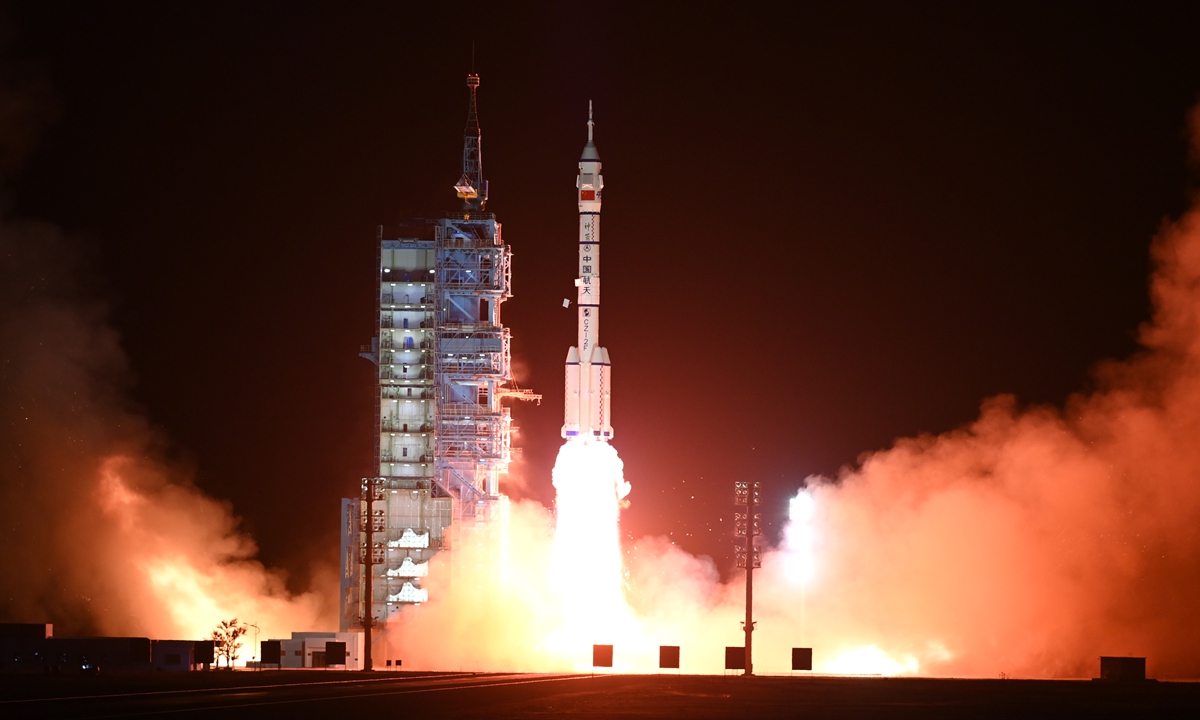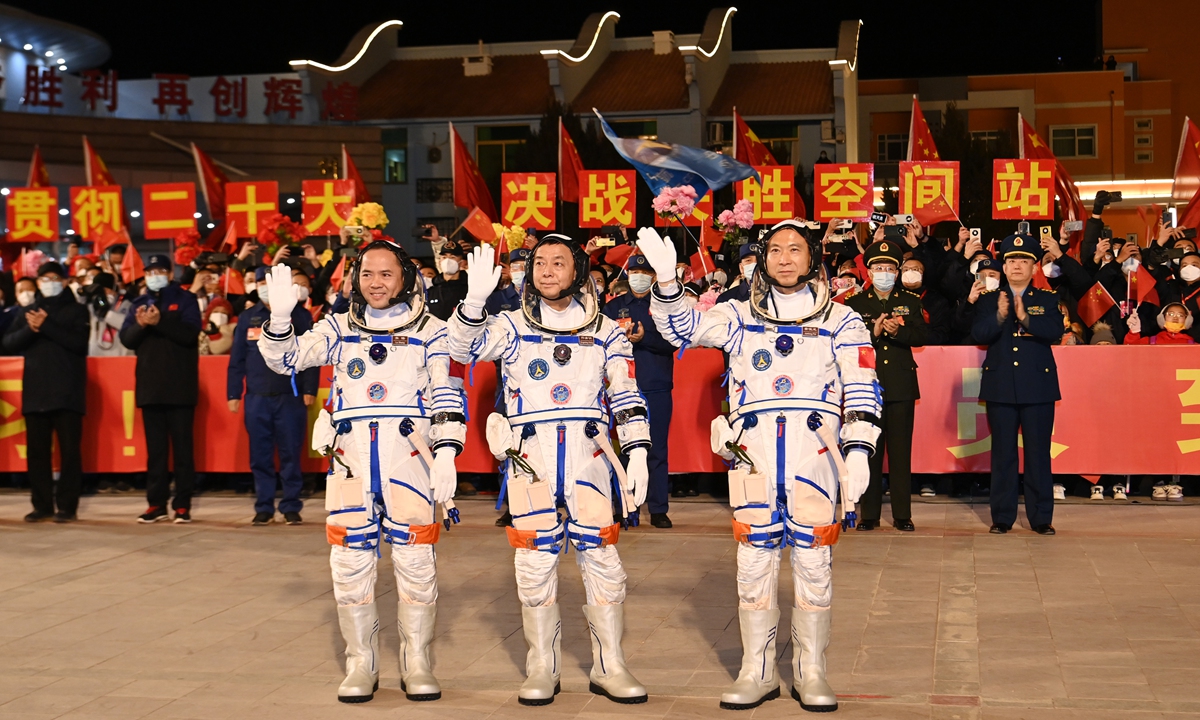
Long March-2F Y15 rocket, carrying the Shenzhou-15 manned spacecraft with three Chinese taikonauts aboard, blasts off from the Jiuquan Satellite Launch Center in Northwest China's Gansu Province on November 29, 2022. Photo: Wang Jiangbo
China successfully launched the Shenzhou-15 manned spacecraft via a Long March-2F carrier rocket from the Jiuquan Satellite Launch Center on Tuesday, which marked the completion, within two years, of all 11 space launch missions scheduled at the construction stage for the country's first permanent space station.
Carrying the Shenzhou-15 craft, the Long March-2F Y15 rocket took off from the Jiuquan center located in the Gobi Desert in Northwest China's Gansu Province at 11:08 pm Tuesday, and after a flight around 10 minutes, the Shenzhou-15 with a new trio of taikonauts onboard, entered its preset orbit, according to a statement the China Manned Space Agency (CMSA) sent to the Global Times, announcing the success of the launch mission.
The Tuesday launch marks the 11th space launch mission and also the final one at the construction stage of the China Space Station. China began construction of the three-module space station with the launch of Tianhe core module - the main living quarters for the taikonauts - in April 2021.
Despite being under a tight schedule of just 20 months, China has delivered all of the 11 launches - three for mega space station modules, four for Shenzhou manned spacecraft and four for Tianzhou cargo spacecraft - in an uninterrupted sequence of success, reflecting China's robust development in the domain of manned space technology.
It shows once again China's speed and precision, and more importantly, China's reliability to always deliver its plans, Song Zhongping, a space observer and TV commentator, told the Global Times on Tuesday.
Ever since the launch of the country's manned spaceflight program in 1992, China has been marching toward its set goals with unwavering determination and that is what makes it achieve one victory after another, Song noted.
It is also amazing that China has done this on its own, a Beijing-based space analyst who requested not to be named told the Global Times, noting that "it took 15 countries a decade and more than 30 missions to assemble the International Space Station (ISS)."
Several observers also pointed out the completion of China Space Station, which is designed to last for at least one decade in orbit, is of a global significance especially as the aging ISS could cease operations by the end of the decade, and even sooner by 2024.
"The completion of the Tiangong Space Station is a significant technical achievement that China has made. The Chinese station may offer some stability at a time when the US and its partners will be undergoing a period of transition from the ISS to the development and use of commercial space stations," Mariel Borowitz, associate professor with the Sam Nunn School of International Affairs of the Georgia Institute of Technology in the US, told the Global Times via email.
After accomplishing the success of the launch mission, the space station project is to next transit into an application and development phase which will last more than a decade. The Long March-2F carrier rocket, according to its developer China Academy of Launch Vehicle Technology (CALT), will continue to execute manned spaceflight missions at a frequency of twice a year, playing an important role at the space station operational stage.

A see-off ceremony for three Chinese taikonauts of the Shenzhou-15 manned space mission was held on Tuesday evening at the Jiuquan Satellite Launch Center in northwest China, according to the China Manned Space Agency. Photo: Wang Jiangbo
'Six plus six' milestone The Shenzhou-15 crew consists of mission commander veteran taikonaut Fei Junlong and two space newcomers, Deng Qingming and Zhang Lu. It will conduct China's first-ever direct crew handover at the China Space Station with the Shenzhou-14 trio led by commander Chen Dong.
According to the mission plan, the Shenzhou-15 spacecraft will conduct a fast, automated rendezvous and docking with the space station combo at Tianhe core module's front port and then form a new combo of three space crafts and three modules.
It will be the largest structure of the China Space Station to date with a total mass of nearly 100 tons.
"We are about to witness the great sight of a 'six plus six' in space, as we shall have a combination of six space crafts and modules and six taikonauts simultaneously in the orbit some 400 kilometers above the Earth's ground," a mission insider with China's state-owned aerospace giant China Aerospace Science and Technology Corporation and the main contractor of space station project, told the Global Times.
The Chinese astronaut training system revealed on Tuesday that the crew handover will take about six days, during which Shenzhou-14 crew will mainly prepare for their return to Earth, whereas the Shenzhou-15 crew will focus on setting up space station working status and adapting themselves with the space environment and concluding the handover according to plan.
The astronaut training system told the Global Times that the China Space Station has two separate sets of kitchen equipment, enabling the two crews to prepare their own meals at the same time. They can also choose to dine together or separately.
Likewise, there are also two bathrooms and six sleeping booths in Tianhe and Wentian modules, which the two crews could use separately.
During their upcoming six-month stay in the China Space Station, the Shenzhou-15 crew will carry out works including the verification of long-term stays in the space station combo, the unlocking, installation and testing of 15 science experiment cabinets and carrying out more than 40 experiments in the fields of space science research and applications, space medicine and space technology, among others.
They will also conduct three to four extravehicular activities during the mission. They will witness the arrival of the Tianzhou-6 cargo craft and Shenzhou-16 manned spaceship. They will also have a direct handover with the Shenzhou-16 crew in orbit.
According to the Chinese Academy of Sciences (CAS) on Tuesday, two "mini cubes" supporting life science experiments will be taken to the China Space Station.
One of them will be installed in the life science cabinet inside the Wentian space lab to be used for the study and research on space radiation metrology and biological damage assessment technology, the CAS told the Global Times on Tuesday.
The other one will be taken to the life and ecology experiment cabinet, also located in Wentian, to support the study of the impact of microgravity as it is related to plant cell structure and functional molecular network, the CAS explained.
As more experiment units and samples are sent to the China Space Station, there will be more interdisciplinary and long-term experiment series, and in the meantime, those space science payload will be maintained and upgraded to secure the advancement of the space experiment facility, the CAS said.





